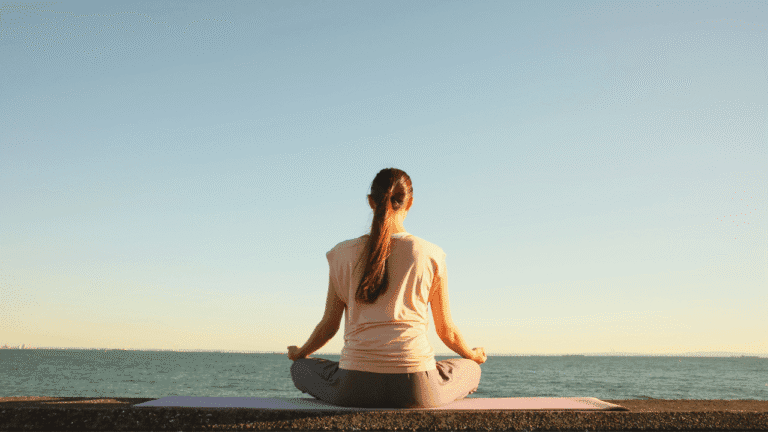Mindfulness in Everyday Activities | Enhance Focus & Joy

Welcome to our article on mindfulness in everyday activities! In this fast-paced world, it’s essential to take a moment to slow down, connect with ourselves, and cultivate mindfulness. Mindfulness goes beyond deep breathing and mantras – it’s about being aware of our internal state and surroundings in our daily lives. By practicing mindfulness, we can improve focus, self-awareness, and overall well-being.
Whether you’re new to mindfulness or looking for new techniques, we’ve got you covered. In this article, we’ll explore various mindfulness exercises and strategies that can be incorporated into your everyday routines. From activities you can do at work to techniques for reducing anxiety, we’ll provide practical tips to help you experience the benefits of mindfulness in different aspects of your life.
So, let’s dive in and explore the exciting world of practicing mindfulness in everyday activities!
Key Takeaways:
- Mindfulness in everyday activities improves focus, self-awareness, and overall well-being.
- It involves being aware of our internal state and surroundings.
- There are various mindfulness exercises and techniques that can be practiced anywhere.
- Mindfulness can be beneficial in different aspects of life, including work and reducing anxiety.
- Cultivating mindfulness allows for a deeper connection with ourselves and the world around us.
What is Mindfulness?
Mindfulness is a practice that involves being fully present and aware of our internal state and surroundings. It goes beyond mere attention and involves forming a holistic relationship with ourselves, cultivating self-awareness, and improving our focus and concentration.
At its core, mindfulness is about understanding and accepting our thoughts, feelings, and physical sensations without judgment or attachment. By developing mindfulness, we can develop a deeper connection with ourselves and the world around us.
The Practice of Mindfulness
Practicing mindfulness can be done in various ways. It can involve sitting quietly and observing our breath, engaging in body scans to connect with our physical sensations, or participating in mindful movement exercises like yoga or walking meditation.
Regardless of the specific technique, the practice of mindfulness allows us to become more aware of the present moment, letting go of distractions and judgments. This heightened awareness enables us to respond to situations with clarity, compassion, and non-reactivity.
Improving Focus and Concentration
One of the key benefits of mindfulness is its ability to enhance our focus and concentration. By practicing mindfulness, we train our minds to stay focused on the present moment, avoiding distractions and reducing mental clutter.
Through regular practice, we can become more skilled at directing our attention to the task at hand, increasing productivity and efficiency. Mindfulness also helps us become more aware of when our minds start to wander, allowing us to gently bring our focus back to the present moment.
A Holistic Relationship with Self
Mindfulness encourages us to develop a holistic relationship with ourselves, encompassing all aspects of our being – mind, body, and spirit. By observing our thoughts, emotions, and physical sensations without judgment, we can develop a greater sense of self-awareness and self-acceptance.
This holistic relationship with self allows us to cultivate compassion, kindness, and forgiveness towards ourselves. It brings about a deep understanding of our inner workings and helps us embrace our strengths and vulnerabilities.
By regularly practicing mindfulness, we can create a space within ourselves to nurture our well-being and find peace amidst the chaos of daily life. It is an invaluable tool for navigating the challenges of a fast-paced world, helping us slow down, connect with ourselves, and live with greater intention.
10 Mindfulness Activities to Find Calm

To find calm in your daily life, incorporating mindfulness activities can be incredibly beneficial. These activities not only help you relax and unwind but also bring focus and tranquility to your mind and body. Here are 10 mindfulness techniques that you can practice:
- Playing the Sound Game: Close your eyes and focus on the sounds around you. Pay attention to each sound, whether it’s the chirping of birds, the rustling of leaves, or the humming of a fan. Notice how each sound comes and goes, without judgment.
- Grounding Your Feet: Take off your shoes and socks and stand barefoot on the ground. Feel the sensation of the earth beneath your feet. Wiggle your toes and notice the connection between your feet and the ground. This grounding technique can help you feel more centered and present.
- Practicing Introspection: Set aside some time for self-reflection. Find a quiet space where you can sit comfortably. Close your eyes and bring your attention inward. Reflect on your thoughts, emotions, and sensations without judgment. This practice allows you to become more aware of your internal state.
- Playing the Chime Game: Listen to the gentle chime or bell sound and focus on the sound as it resonates. Notice how the sound gradually fades away. This activity can help you cultivate mindfulness and enhance your ability to stay present in the moment.
- Practicing Stillness: Find a comfortable seated position and bring your attention to your body. Notice any areas of tension or discomfort. Take slow, deep breaths as you relax your muscles and allow yourself to be still. This exercise promotes relaxation and calmness.
- Following Your Breathing: Sit or lie down in a quiet space and focus on your breath. Pay attention to each inhalation and exhalation. Notice the sensation of your breath entering and leaving your body. This mindfulness technique can help you find calmness and clarity.
- Eating Slowly: Instead of rushing through meals, take the time to savor each bite. Pay attention to the flavors, textures, and smells of your food. Chew slowly and mindfully, fully experiencing each bite. This practice can bring a sense of calm and gratitude to your meals.
- Lighting a Candle: Find a quiet space and light a scented candle. As you watch the flame flicker, take deep breaths and allow yourself to become present in the moment. The soft glow and calming scent can create a soothing atmosphere.
- Playing the Name Game: List names of people, places, or objects that you associate with positivity or joy. Say each name out loud, focusing on the pleasant emotions they evoke. This activity helps shift your attention to positive aspects and promotes a calm state of mind.
- Walking Outside: Take a mindful walk outdoors and immerse yourself in nature. Pay attention to the sights, sounds, and sensations around you. Feel the grass beneath your feet, listen to the birds singing, and notice the gentle breeze on your skin. This activity can help you find calmness and reconnect with the present moment.
By incorporating these mindfulness activities into your daily routine, you can cultivate a sense of calm and tranquility that will benefit your overall well-being. Find time each day to practice these techniques and embrace the peace they bring.
6 Mindfulness Activities You Can Do at Work

Mindfulness activities can have a profound impact on your work life, enhancing focus, productivity, and job satisfaction. Incorporating mindfulness techniques into your work routine can help you stay present, manage stress, and improve your overall well-being. Here are six mindfulness activities you can easily do at work:
- Set Intentions: Start your workday by setting mindful intentions. Take a moment to reflect on the purpose and meaning behind your tasks, reminding yourself of the positive impact your work has on others. This can elevate your motivation and bring a sense of fulfillment to each task.
- Organize Your Workspace: Creating a clean and organized workspace can promote a sense of calm and clarity. Clear away any clutter and arrange your desk in a way that promotes a sense of harmony and focus. A tidy workspace can help reduce distractions and increase productivity.
- Approach Emails Mindfully: Instead of reacting in a rushed or stressed manner when receiving emails, practice approaching them with a productive mindset. Take a deep breath before opening each email and read them mindfully, responding thoughtfully and intentionally.
- Group Similar Tasks Together: Multitasking can often lead to decreased focus and increased stress. Instead of switching between tasks, try grouping similar tasks together and dedicate focused time to complete them one by one. This approach allows you to maintain concentration and work efficiently.
- Practice the Pomodoro Technique: The Pomodoro Technique is a time management method that involves working for a specific period, typically 25 minutes, followed by a short break. This technique can help improve your ability to stay focused and productive, while also providing regular restful breaks for relaxation and rejuvenation.
By incorporating these mindfulness activities into your workday, you can cultivate a more mindful and balanced approach to work, leading to improved focus, job satisfaction, and overall well-being.
5 Mindfulness Activities to Reduce Anxiety
Anxiety can be overwhelming and impact our mental well-being. Luckily, there are effective mindfulness activities that can help reduce anxiety and promote a sense of calm. Incorporating these activities into your daily routine can provide relief from stress and empower you to navigate anxious moments with greater ease. Here are five mindfulness techniques for anxiety reduction:
Coloring and Drawing: Engage in the soothing practice of coloring or drawing. This activity promotes relaxation, allows you to focus on the present moment, and encourages creativity. Choose intricate patterns or simply unleash your imagination on a blank canvas. Not only is coloring and drawing an enjoyable way to reduce anxiety, but it also serves as a form of self-expression.
Music Therapy: Music has a powerful impact on our emotions. Use music as a mindfulness technique by creating a playlist of calming and soothing songs. Find a quiet and comfortable space, close your eyes, and allow the music to wash over you. Pay attention to the lyrics, melody, and how the music makes you feel. Music therapy can effectively reduce anxiety and create a peaceful state of mind.
Full-Body Scan: Dedicate some time to practicing a full-body scan meditation. Find a comfortable position, close your eyes, and gradually bring your attention to different parts of your body. Notice any sensations without judgment or the need to change anything. This practice promotes self-awareness and helps release tension from your body, reducing anxiety in the process.
Self-Compassion: Show yourself kindness and understanding through the practice of self-compassion. When anxiety arises, acknowledge your feelings without judgement and offer yourself comforting words of support. Remind yourself that it’s okay to feel anxious, and that you are capable of navigating through it. Cultivating self-compassion can help alleviate anxiety and promote emotional well-being.
Box Breathing Technique: Utilize the power of your breath to calm anxiety with the box breathing technique. Find a comfortable position and inhale deeply for a count of four. Hold your breath for four counts, then exhale slowly for four counts. Pause for another four counts before repeating the cycle. This technique helps regulate your nervous system, reducing anxiety and promoting a sense of relaxation.
By incorporating these mindfulness activities into your daily routine, you can find relief from anxiety and cultivate a greater sense of inner peace. Experiment with different techniques to discover which ones resonate with you the most. Remember, mindfulness is a journey, and with practice, you can develop the tools to effectively reduce anxiety and lead a more balanced life.
| Mindfulness Activity | Benefits |
|---|---|
| Coloring and Drawing | Promotes relaxation and self-expression |
| Music Therapy | Calms the mind and soothes anxiety |
| Full-Body Scan | Increases self-awareness and releases tension |
| Self-Compassion | Reduces self-judgment and fosters emotional well-being |
| Box Breathing Technique | Regulates the nervous system and induces relaxation |
4 Mindfulness Activities You Can Do in a Group
Mindfulness is not limited to individual practice. In fact, practicing mindfulness in a group setting can enhance the experience, fostering connection and shared experiences. Here are four mindfulness activities that you can enjoy with others:
- Laughter Yoga: Gather in a circle and engage in laughter exercises. This playful activity combines laughter and deep breathing to boost mood, reduce stress, and promote a sense of connection.
- Deep Partner Breathing: Pair up with a partner and sit facing each other. Take turns guiding deep inhalations and exhalations, synchronizing your breath. This activity cultivates a sense of trust, compassion, and relaxation.
- Blindfolds for Sensory Exploration: Have everyone in the group put on blindfolds. Encourage them to utilize their other senses, such as touch, taste, and sound, to explore objects or engage in group activities. This exercise heightens awareness and deepens the experience of being present.
- The Move and Freeze Game: Play a game where everyone moves freely within a designated space. When a leader gives the signal to freeze, participants pause and become fully present in their body and surroundings. This activity promotes self-awareness, focus, and mindfulness in motion.
These group mindfulness exercises facilitate mindfulness, bonding, and self-awareness. They offer a unique opportunity to engage in mindful practices collectively, enhancing the overall well-being of the group.
6 Mindfulness Activities for Your Morning Ritual
Incorporating mindfulness into your morning routine can have a profound impact on your overall well-being. Starting the day with mindfulness practices allows you to cultivate a calm and centered mindset that can set a positive tone for the rest of your day. By dedicating a few moments to these mindfulness activities, you can enhance self-awareness, focus, and intentionality as you embark on your daily journey.
1. Establish a Morning Routine
Creating a structured morning routine provides a sense of stability and allows you to ease into the day mindfully. Set aside dedicated time for activities that nurture your mind, body, and soul. Whether it’s reading a book, practicing yoga, or enjoying a leisurely breakfast, incorporating activities that bring you joy and peace can promote a mindful start to your day.
2. Write in a Gratitude Journal
Writing down things you are grateful for each morning cultivates a mindset of gratitude and positivity. Take a few moments to reflect on the blessings in your life and jot them down in a gratitude journal. This simple practice can shift your focus towards the abundance and beauty that surrounds you.
3. Wake Up with Plenty of Time
Rushing through your morning can leave you feeling stressed and anxious. Instead, aim to wake up with plenty of time to complete your morning routine without feeling hurried. By allowing yourself extra time in the morning, you can move through your activities mindfully, savoring each moment.
4. Visualize Goals for the Day
Before diving into your daily tasks, take a moment to visualize your goals for the day. Close your eyes and imagine yourself successfully accomplishing your tasks, feeling a sense of fulfillment and satisfaction. This visualization exercise can help set a positive intention and focus your mind on what’s truly important.
5. Try Guided Meditation
Engaging in a guided meditation practice in the morning can help you cultivate a calm and clear mind. Find a quiet and comfortable space, close your eyes, and follow along with a guided meditation. This practice allows you to connect with your breath, release tension, and start the day with a sense of presence and peace.
6. Practice Mindful Eating
Instead of rushing through your breakfast, savor each bite mindfully. Pay attention to the flavors, textures, and sensations of the food. Take your time, chew slowly, and fully engage your senses. This practice not only enhances your connection with food but also allows you to cultivate mindfulness throughout the day.
By incorporating these mindfulness activities into your morning ritual, you can create a harmonious and intentional start to your day. These practices will help you bring a sense of awareness, calmness, and positive energy into every aspect of your life.
Conclusion
Mindfulness activities offer numerous benefits for individuals seeking to enhance their overall well-being. By incorporating mindfulness into daily life, individuals can experience increased self-esteem, optimism, and overall life satisfaction. One of the key advantages of mindfulness is its ability to promote stress reduction and manage stress levels. Through the practice of mindfulness, individuals can develop a heightened sense of self-awareness, allowing them to better understand and accept their thoughts, emotions, and physical sensations.
The beauty of mindfulness is its accessibility. It can be practiced anywhere and at any time, making it a versatile tool for cultivating a deeper connection with oneself and the world around us. By adopting mindfulness in daily life, individuals can enhance their focus, cultivate a sense of calmness, and find joy in their everyday activities.
Embarking on a mindful journey is a powerful step towards personal growth and well-being. Whether it’s incorporating mindfulness exercises into morning rituals, practicing mindfulness techniques for anxiety reduction, or introducing mindfulness activities in group settings, the benefits of mindfulness are boundless. So why wait? Start your own mindful journey today and experience the transformative power of mindfulness in your daily life.












